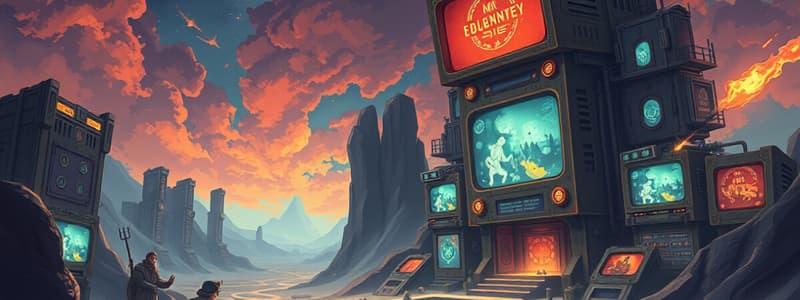Podcast
Questions and Answers
The printing press for mass production was developed in the _____ century.
The printing press for mass production was developed in the _____ century.
20th
The first telephone was invented in 1876.
The first telephone was invented in 1876.
True (A)
Which media form was developed in 130 BC in Rome?
Which media form was developed in 130 BC in Rome?
- Clay Tablets
- Printing Press
- Acta Diurna (correct)
- Cave Paintings
What was a notable form of media created during the Industrial Age?
What was a notable form of media created during the Industrial Age?
Match the following inventions with their invention years:
Match the following inventions with their invention years:
Which of the following was invented in 1941?
Which of the following was invented in 1941?
The first web browser was Internet Explorer.
The first web browser was Internet Explorer.
______ was the first microblogging platform launched in 2006.
______ was the first microblogging platform launched in 2006.
What technology began to dominate in the New/Information Age?
What technology began to dominate in the New/Information Age?
Which personal computer was released first?
Which personal computer was released first?
Flashcards are hidden until you start studying
Study Notes
Pre-Industrial Age (Before 1700)
- Emergence of fire, paper from plants, and metalworking with tools made of stone, bronze, copper, and iron.
- Key media forms included:
- Cave Paintings: Dating back to 35,000 BC, they are some of the earliest forms of human expression.
- Clay Tablets: Utilized in Mesopotamia around 2400 BC for record-keeping and communication.
- Papyrus: Developed in Egypt circa 2500 BC, it became an important writing medium.
- Acta Diurna: Established in Rome in 130 BC as a form of public communication, similar to a newspaper.
- Dibao: A Chinese publication from the 2nd Century, serving as an early news sheet.
- Codex: Used in the Mayan region by the 5th Century as a format for books.
- Printing Press (Wood Blocks): Invented around 220 AD, allowing for the reproduction of texts.
Industrial Age (1700s to 1930s)
- Defined by the use of steam power, machine tools, and mass production techniques.
- Key media advancements included:
- Printing Press for Mass Production: Revolutionized publishing by 1900, enabling widespread book distribution.
- The London Gazette: First published in 1740, it was an early newspaper in England.
- Typewriter (1800): Streamlined writing processes, enhancing communication and documentation.
- Telephone (1876): Innovated personal and professional communication over distances.
- Motion Pictures: Development began around 1890, resulting in early film exhibitions.
- Telegraph: Enhanced long-distance messaging capabilities.
Electronic Age (1930s to 1980s)
- Marked by the invention of the transistor, which led to advancements in electronic communication.
- Influential media forms included:
- Transistor Radio: Allowed for portable access to radio broadcasts.
- Television (1941): Became a primary medium for entertainment and news.
- Mainframe Computers: Large electronic computers, like the IBM 704, emerged in the 1960s.
- OHP and LCD Projectors: Innovated presentations and educational formats.
New/Information Age (1900s to 2000s)
- The Internet revolutionized communication and information access.
- Significant developments included:
- Web Browsers: Mosaic (1993) and Internet Explorer (1995) facilitated web navigation.
- Blogs: Platforms like Blogspot (1999) and Wordpress (2003) enabled public discourse.
- Social Networks: Friendster (2002) started a trend, followed by Multiply (2003), Facebook (2004), and Instagram.
- Microblogs: Twitter (2006) and Tumblr (2007) introduced succinct content sharing.
- Video Sharing: YouTube (2005) became a platform for video content creation.
- Portable Computers: Laptops debuted in 1980, and tablets reached the market by 1993.
- Smartphones and Wearable Technology: Revolutionized personal communication and data interaction.
- Search Engines: Google (1997) and Yahoo (1995) transformed information retrieval.
- Video Chat: Innovations like Skype (2003) made face-to-face communication easier across distances.
Studying That Suits You
Use AI to generate personalized quizzes and flashcards to suit your learning preferences.




